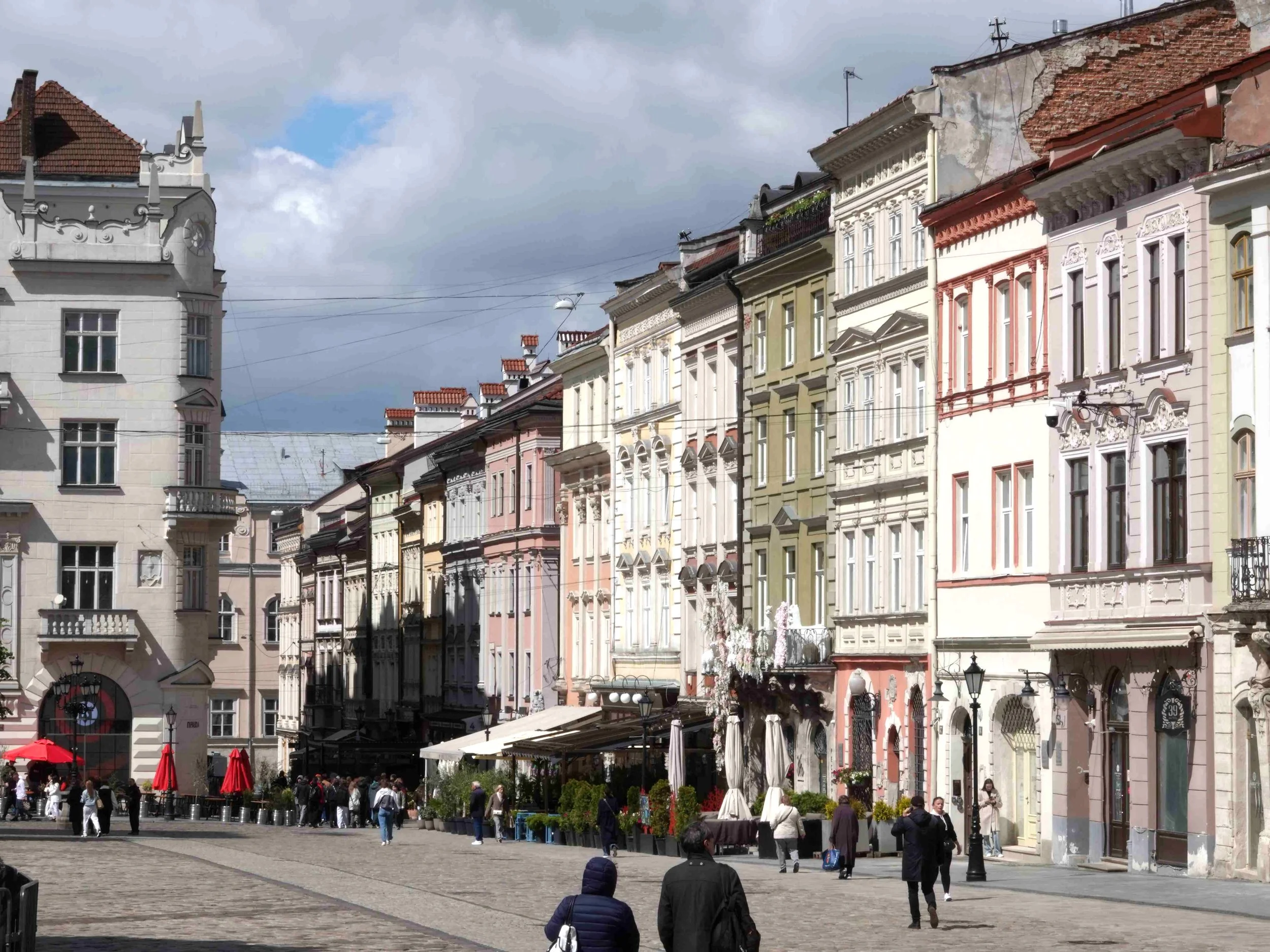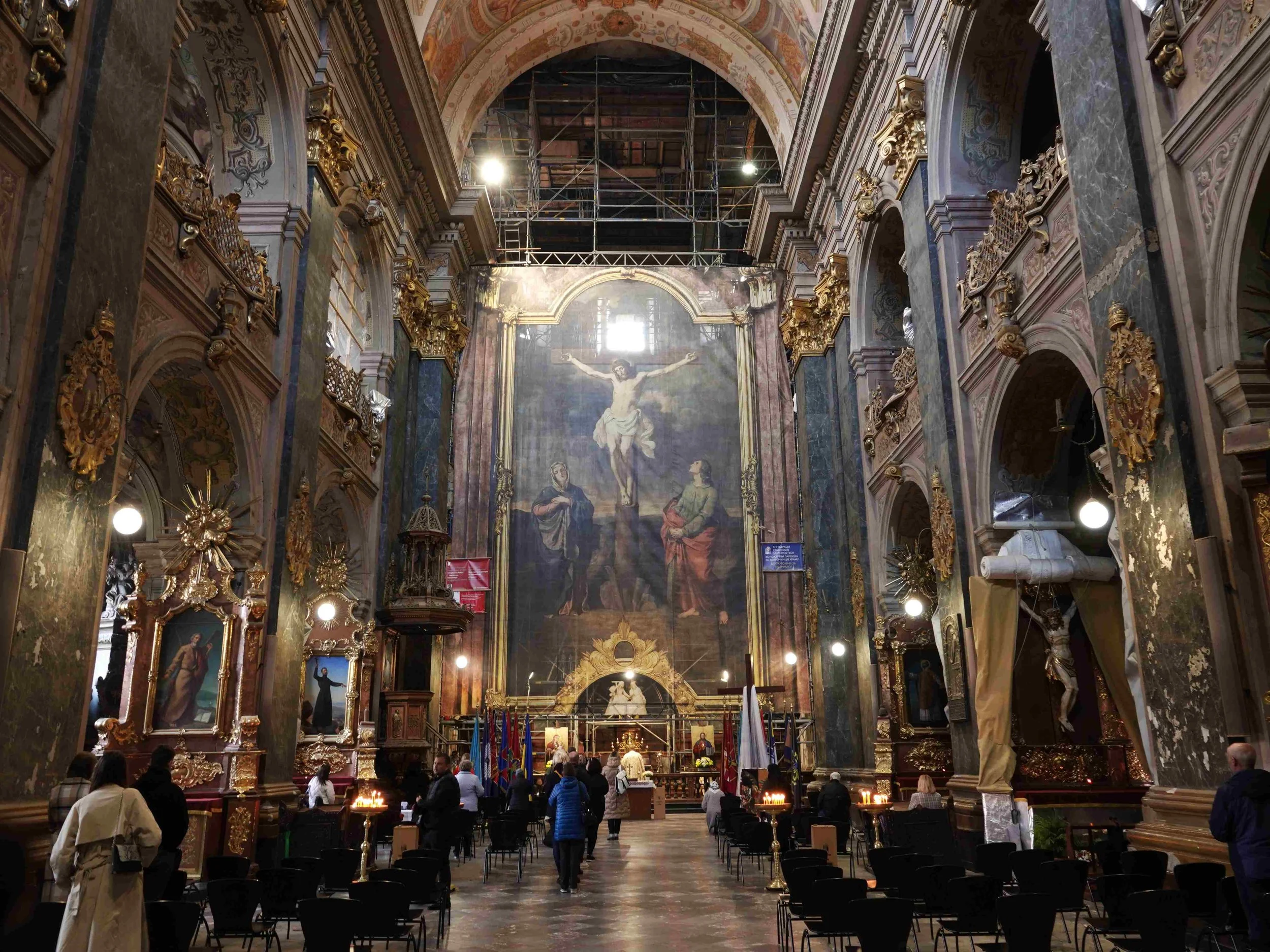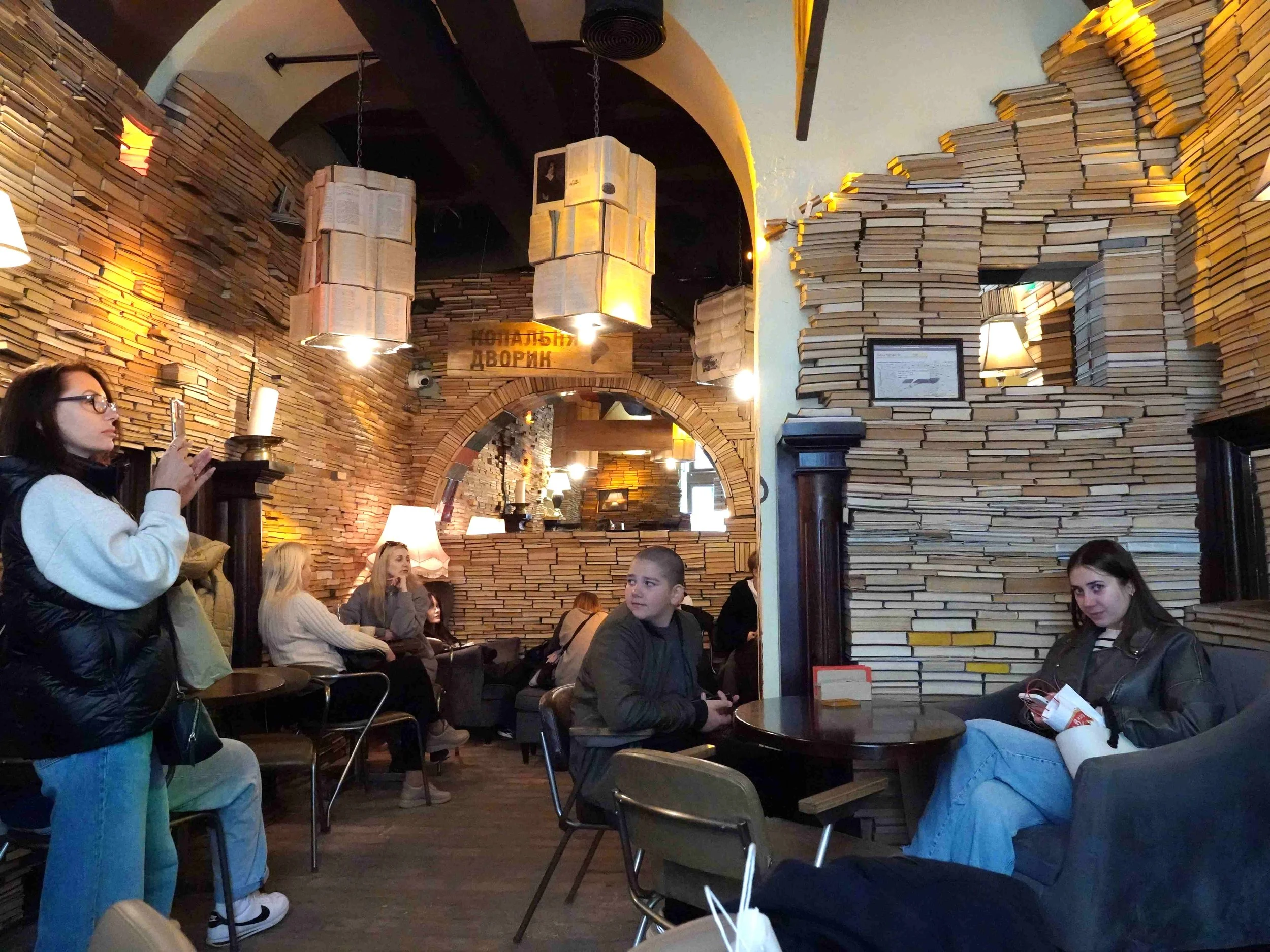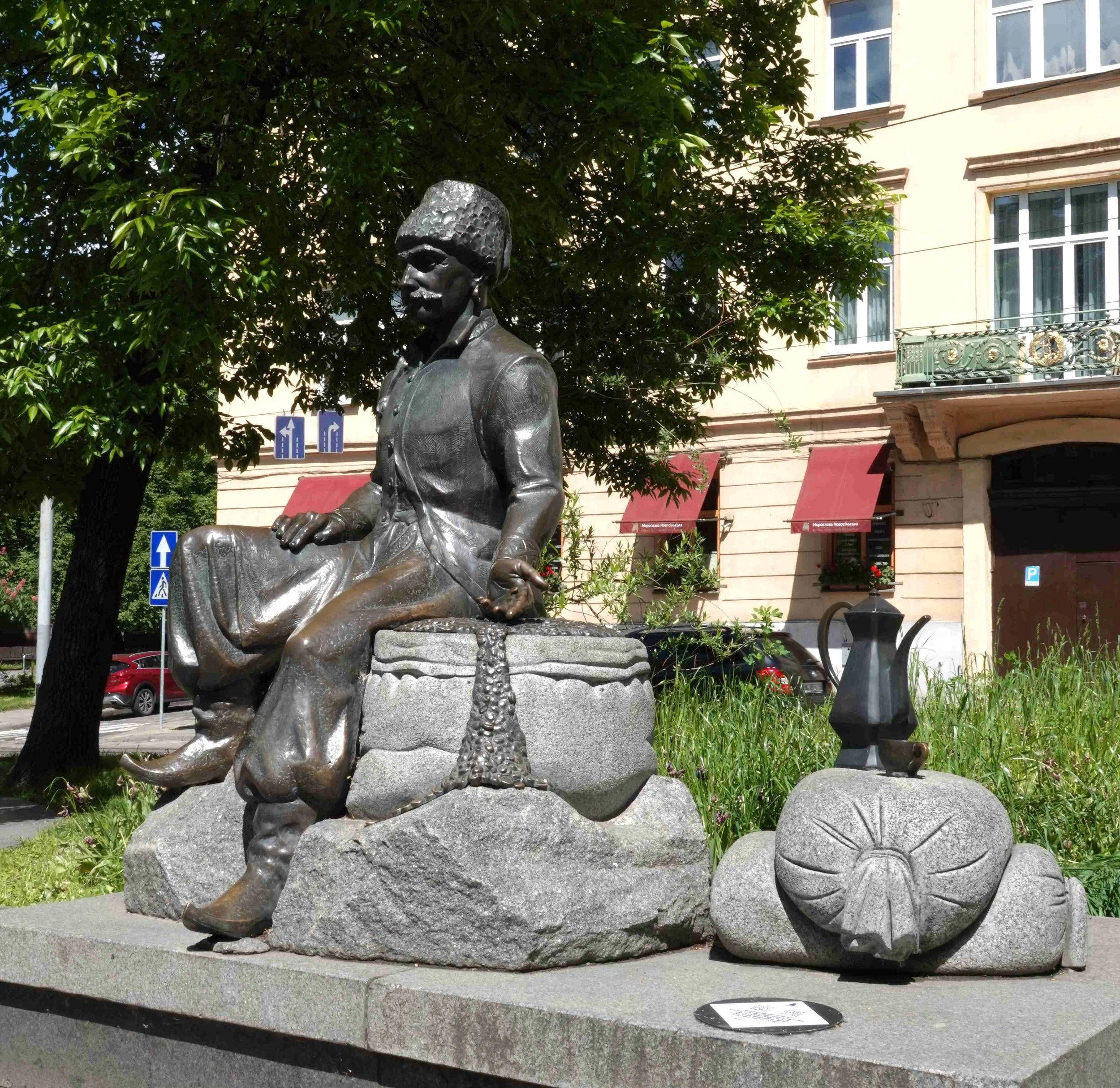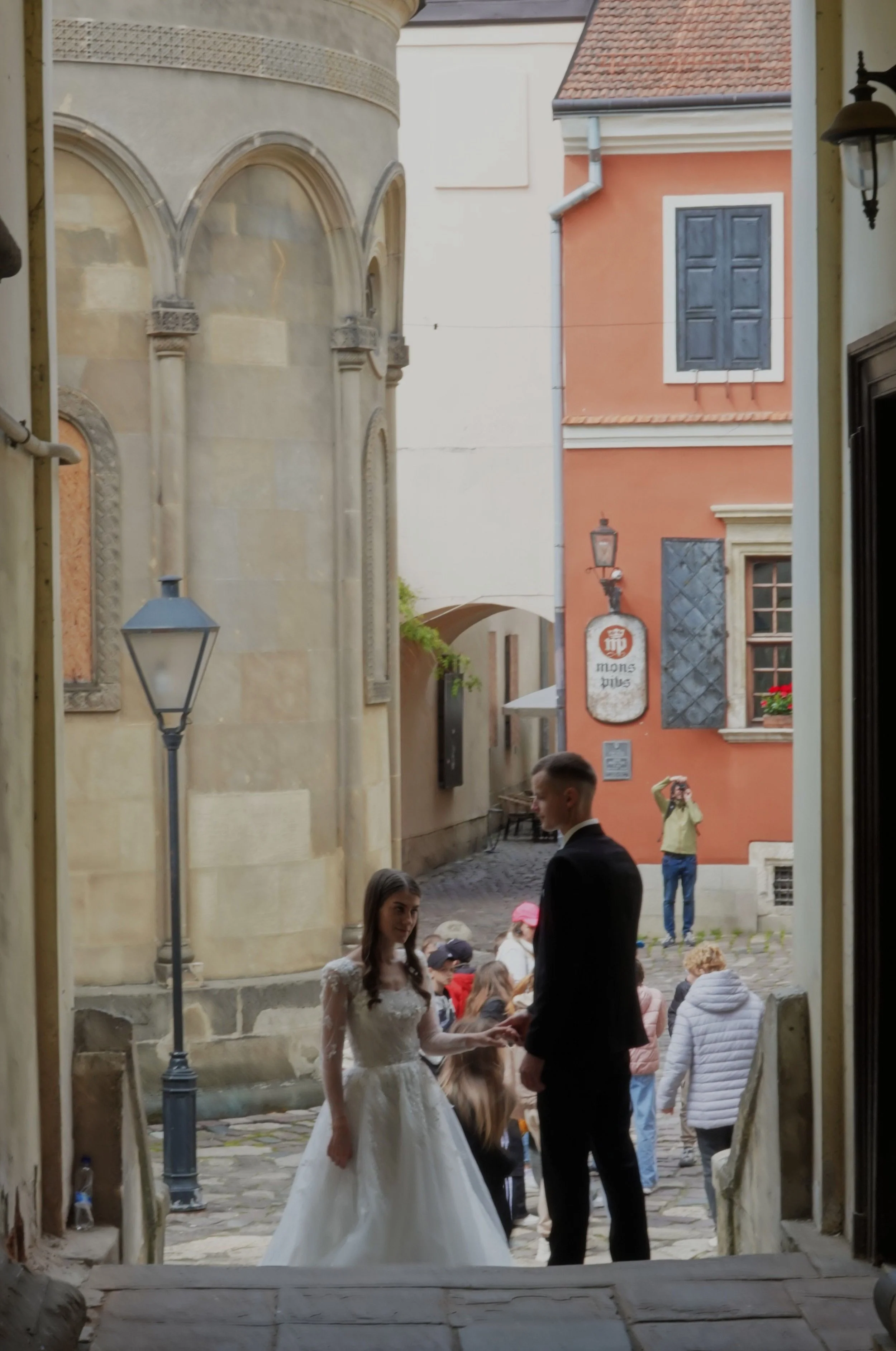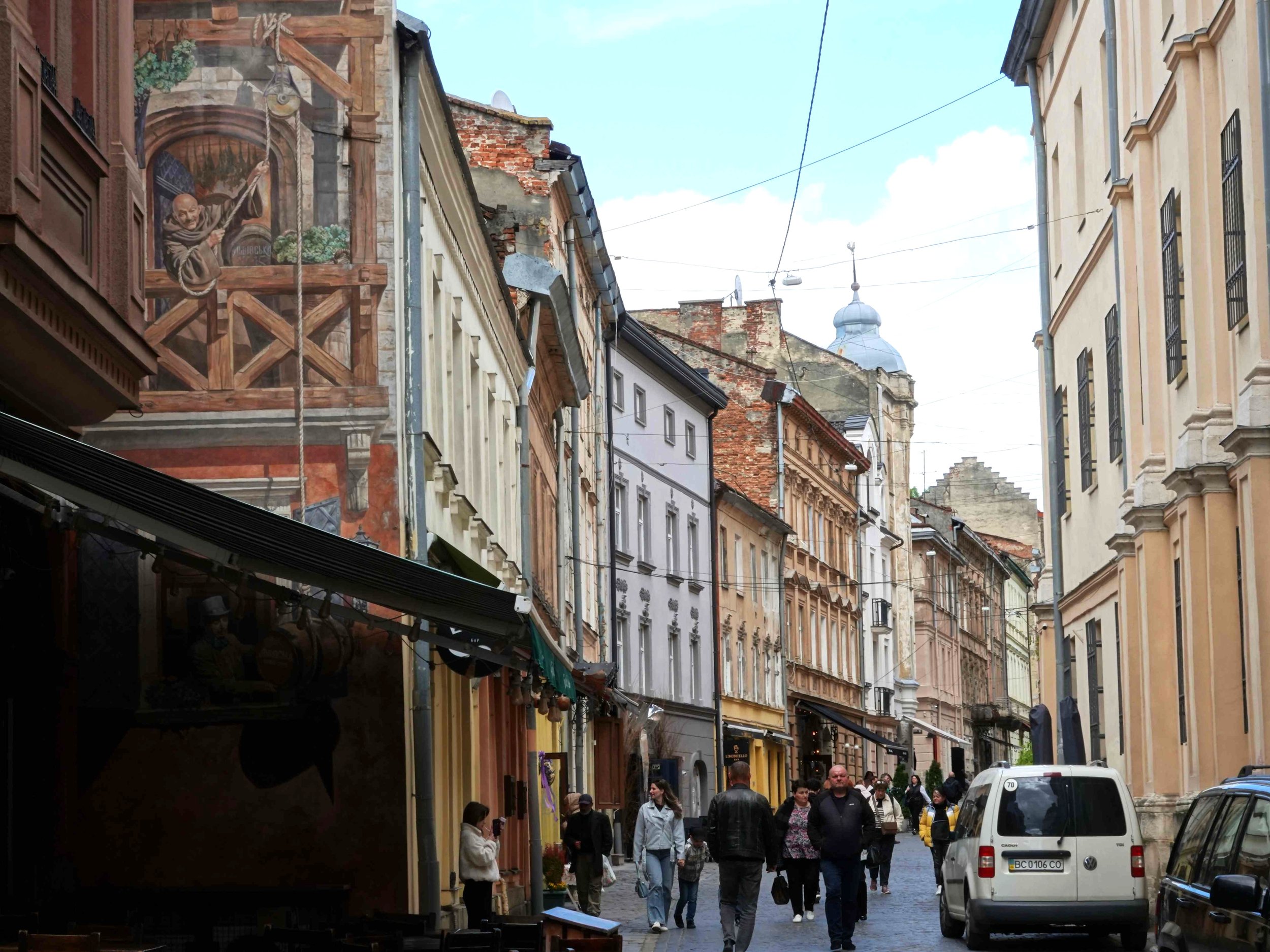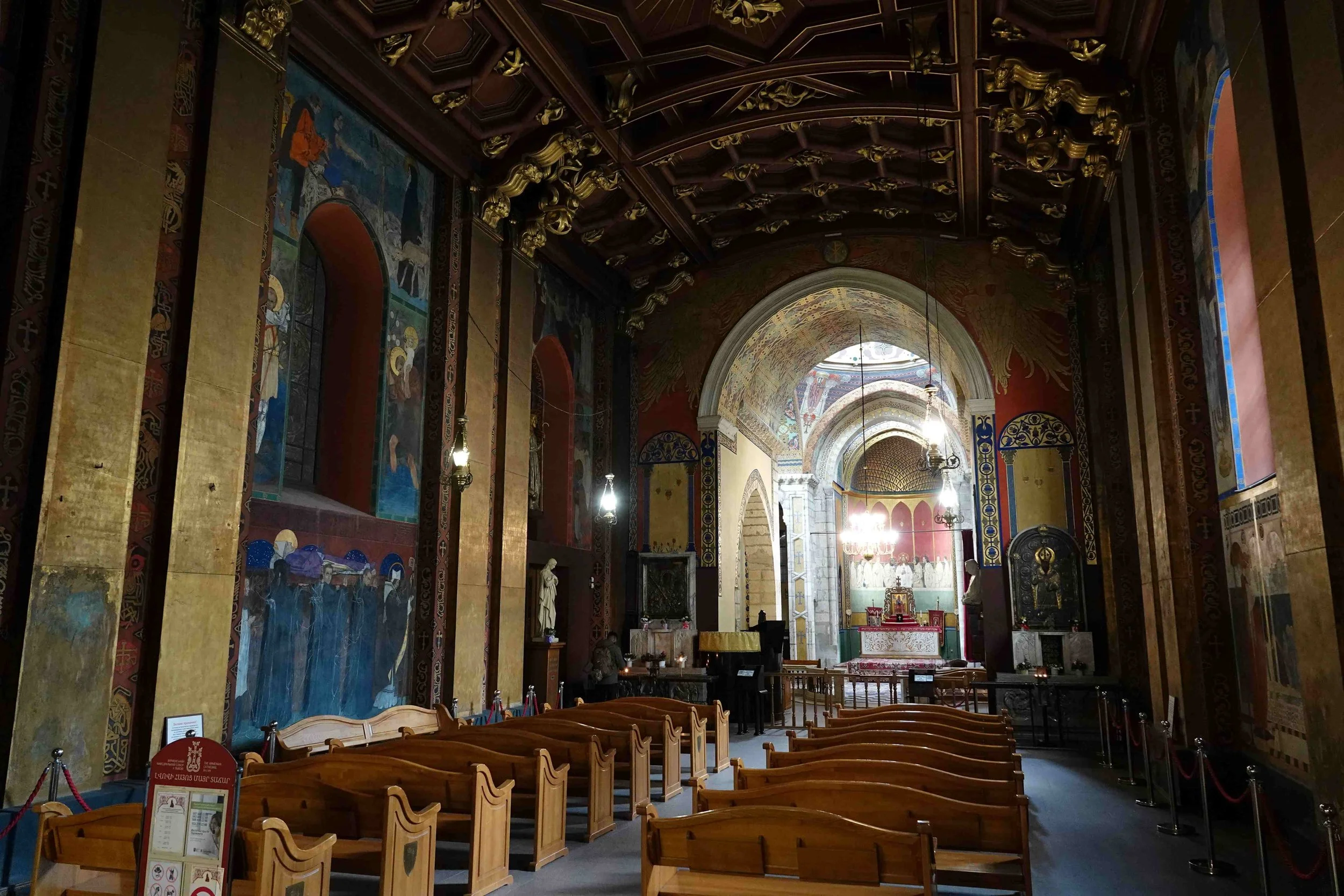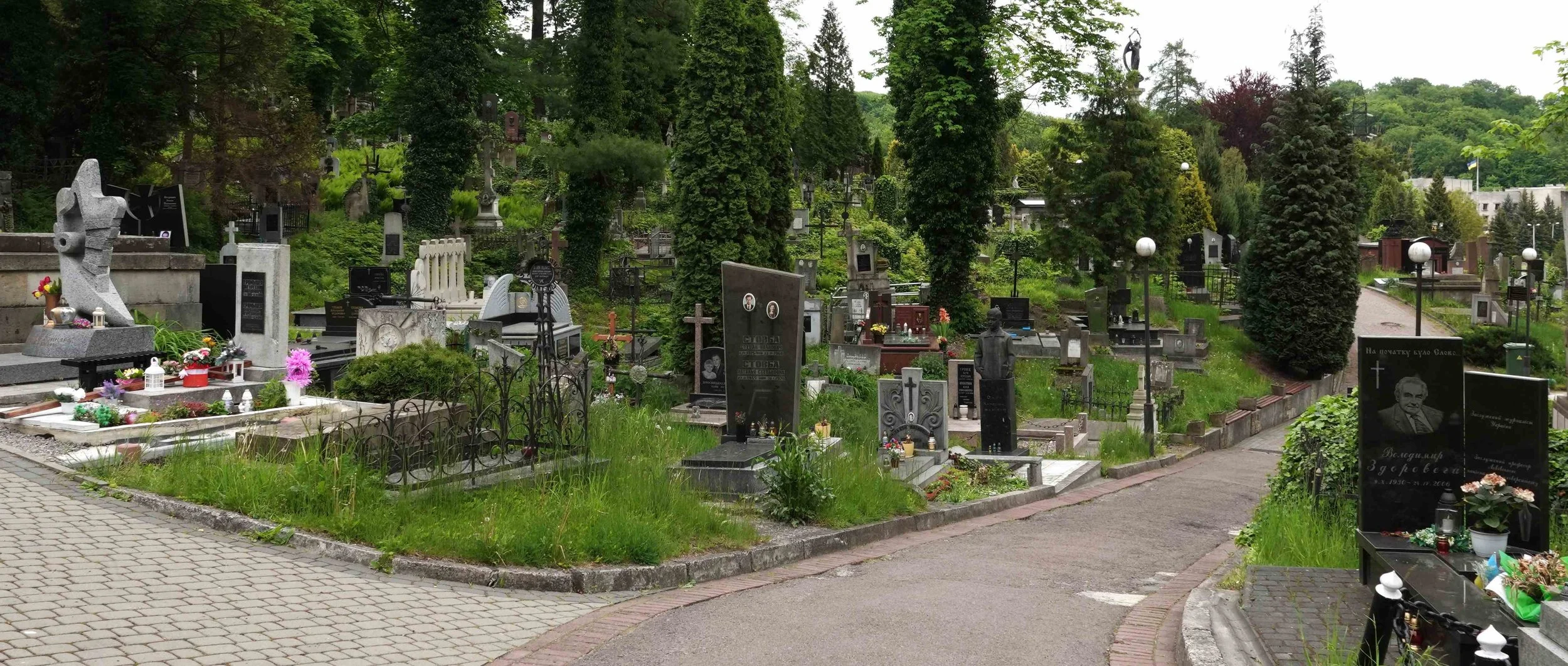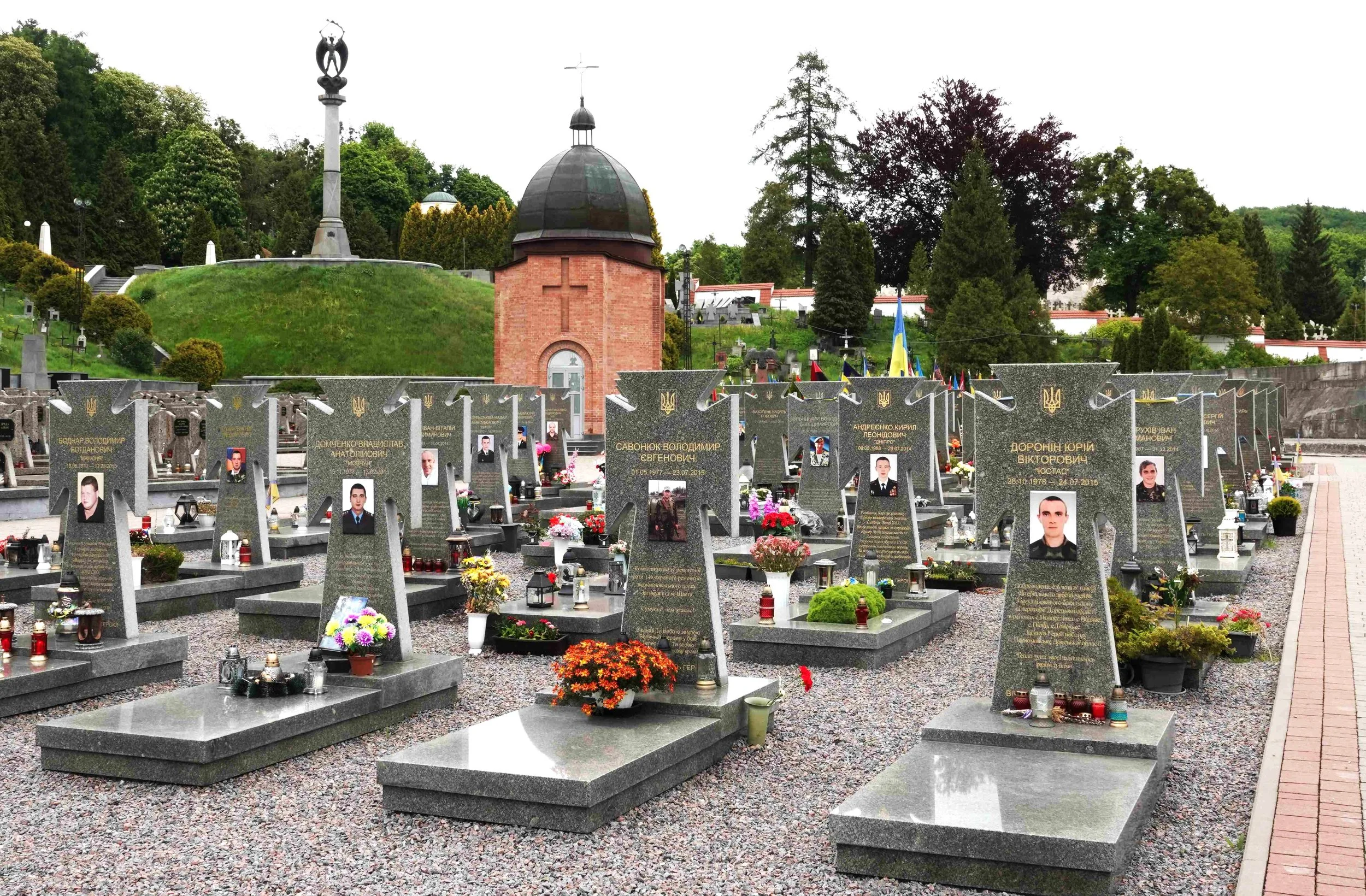Lviv, cradle of modern Ukrainian language and culture
View from the clock tower on the main square — very Central European, as you can see.
Lviv (“City of Lions”) is the 5th largest city in Ukraine and the largest city in the Western region. The history here is fundamentally different from the rest of the country, because Lviv and surroundings were never under Russian control until 1939. In the preceding centuries Lviv was either called Lwow (pronounced “Lvoof”) as part of Poland, or Lemberg as part of the Austrian Empire. And unlike Russia, Austria and Poland did not repress Ukrainian language or culture.
View on the main square
1820-1920 is generally defined as the Era of National Awakening in Europe, when dozens of nationalities where discovering who they are and defining who they wanted to be on a post-imperial continent. For much of this time it was a felony to teach, write or publish in Ukrainian in Kyiv or the rest of Russian-ruled Ukraine. Russia called Ukrainians “little Russians”, insisted their language is just a dialect and demanded total assimilation. And in eastern Ukraine, Russia succeeded — most ethnic Ukrainians adopted Russian as their first language. Whereas here in Lviv and surroundings, Ukrainians spoke Ukrainian. Kyiv was bi-lingual. Here in Lviv, people were forced to learn Russian from 1939 to 1991, but now many young people no longer learn it at all, and older people use it only when absolutely necessary.
The linguistic divide is a source of tension. Western Ukrainians want Easterners to learn the national language. All children learn it because all school is now taught in Ukrainian. But the older the person, the harder it is to change. Russian speakers were once under suspicion in western Ukraine because of the ease with which Putin took Crimea, Donetsk and Luhansk in 2014, all of which are Russian-speaking and have sizeable ethnic Russian populations. But Russian-speaking ethnic Ukrainians have proven their loyalty many times over since 2022. This was one of Putin’s biggest miscalculations.
In Lviv and surroundings, Ukrainian language and literature were allowed to develop freely under both Austrian and Polish governance. 1820-1920 was Europe’s Era of National Awakening, when many modern European nationalities really defined themselves. Ukraine’s intellectuals could publish, discuss, debate and teach in Lviv without restriction, and then distribute those materials (sometimes illegally) across wider Ukraine. So this area can fairly be called the cradle of modern Ukrainian culture and national identity.
Taras Shevchenko, Ukraine’s national poet. He lived his entire life in Russian-controlled areas, and was setnenced to a Siberian gulag for writing pro-Ukraine verses in colloquial Ukrainian. He died young, but his works live on. Behind the statue is the city’s main cathedral which is Greek Catholic, a.k.a. Uniate. They practice Eastern Rites, but they recognise the Pope in Rome so they are Catholic. So the religion is a mix of Polish and Russian, just as the language is.
And just as importantly, the Russian pogroms never reached here. The Holodomor -- Stalin’s manufactured famine from 1930-33 that exterminated millions of Ukrainian farmers -- never reached here. Only in the twilight years of Stalinism did Russia gain control of this area. Had this area been under Russian domination for centuries, it’s questionable whether a Ukrainian national identify would have survived.
One of the near-daily funeral processions passing through the main square. It’s very rare for a missile or drone to get through the air defences this far west, but four things constantly remind you a war is on: (1) the funerals, (2) the many disabled veterans, (3) the ubiquitous red-and-black flags of the Ukrainian nationalists who fought both the Nazis and the Communists in World War II (they were only active here in the West), and (4) language. As a Russian speaker, I was surprised to hear Russian on the street constantly, especially given that most store staff give you a blank stare if you speak Russian. The Russian speakers on the street are all refugees from the war-ravaged Russian-speaking East of the country.
This area remained a hotbed of Ukrainian nationalist resistance long after 1945, with nationalist guerillas continuing to fight the Soviets until the 1960s.
Interior of the Greek Catholic (a.k.a. Uniate) cathedral, currently undergoing renovations
The Cossack Hostel where I stayed in Lviv fittingly displays a large reproduction of probably the most famous Cossack-themed painting in history – Ilya Repin’s “The Cossacks of the Zaporozhiya Write a Letter to the Turkish Sultan” (late 19th-century). According to legend, after the Cossacks defeated the Ottoman Turks in battle, the Sultan wrote to the Cossacks saying that with his superior numbers he was bound to win eventually, so they should just be sensible and surrender. Their response to the Sultan’s letter is lost to time, but it was probably something along the lines of “Russian Warship Go F*ck Yourself”.
Lviv’s many good cafes and good coffee are a legacy of Austrian rule from 1795-1919. This cafe literally has walls of books.
Another cafe
A Ukrainian Cossack who took part in the defence of Vienna against the Turks 400 years ago, and then helped introduce coffee to Europe
Lviv has several cellar bars and restaurants, of which by far the most famous is Kryivka. During the war, nationalist partisan fighters hid in these catacombs and used them as a base for raids against both the Nazis and the Reds. It has a wide range of memorabilia from that period, as well as a rifle range where you can shoot an airgun at a portrait of Putin. Get there before 6:30 PM or you’ll never get a table, they don’t take reservations. The password to get in is “Slava Ukraini” (“Glory to Ukraine”), and the customary response, “Heroiam Slava” (“to the Heroes Glory”).
In Kryivka’s gift shop. Former British Prime Minister Boris Johnson (a steadfast ally of Ukraine, when he wasn’t preoccupied conceiving illegitimate children or taking money from special interests) is a popular figure in Ukraine. Somehow milk stout indeed seems like a fitting beer to bear his likeness (wearing a Ukrainian tie, of course!).
In Kryivka’s must-visit souvenir shop. The beer is called “Putin is a dick” (it sounds worse in Ukrainian). The flask is inscribed “Freedom or Death”.
The doormat says “Wipe your feet!”
Me at the entrance of the 5th Cellar, one of Lviv’s many catacomb beer cellar restaurants
In the 5th Cellar
Retrieving Excalibur in the 5th Cellar
At the 5th Cellar with my new friend Anton. He’s a Filipino-American who works in Krakow, and popped across the border for a weekend. We met up as we were both trying to get into Kryivka at around 8 PM, by which time all tables are full
Wedding at the Armenian Orthodox Church in Lviv’s centuries-old Armenian Quarter
On the Armenian street. See the mural of a monk eagerly pulling up a barrel of beer? One of Lviv’s many microbreweries is there.
Interior of the 14th-century Armenian Church
Remains of Lviv’s main synagogue, destroyed by the Nazis in 1942. The gravestones are part of a memorial now. Ukraine was home to over 2 million Jews in 1941, many tracing their ancestry back to 1492 when Spain and Portugal expelled all Jews. Today there are only around 40,000.
Putin now tries to claim that the Ukrainian government and its Jewish president are Nazis. It is true that after the Holodomor (the 1930s famine engineered by Stalin to exterminate Ukraine’s private farmers), many Ukrainians initially welcomed the Nazis as liberators in 1941. But that changed quickly, and the vast majority of Ukrainian nationalists fought both the Nazis and the Reds. The senior rabbi in Kyiv has called on Trump to support Ukraine.
An al fresco restaurant adjacent to the city’s medieval fortifications
Medieval fortifications
The Lychakiv Cemetery has been the city’s most prestigious eternal residence for some time.
Soldiers who died fighting Russia in the initial limited war from 2014-2022
A new area has been opened for those who have died fighting since Putin’s 2022 invasion. Virtually every grave has both a yellow-and-blue national flag, as well as the red-and-black flag of the Ukrainian nationalists who fought both the Nazis and the Reds during World War II, and continued a guerilla war against the Reds into the 1960s. You won’t see that flag in Kyiv because the nationalists were only active here, in the area that was part of Poland until 1939. The rest of Ukraine had been half-exterminated in Stalin’s Holodomor famine.
On the 6-hour train ride from Lviv to Kyiv I had a fascinating chat with Mikhail Kokorich (centre) and Ihor Kramarenko (right) about the last 30 years of politics, the war, and Russian and Ukrainian relations generally. Mikhail’s life story is fascinating. He’s a Russian Jew and Stanford MBA graduate who was astonishingly able to start and run a retail business in Russia in the 2000’s without paying any mafia protection racket (the mining industry was another story). He left Russia after the failure of the Bolotnaya protests against Putin’s dictatorship in 2011, which he had helped to fund. He created a company in Silicon Valley that grew to 500 staff. During Trump’s first term, ICE raided him, handcuffed him and put him in leg irons. But back then a lawyer could still assert your constitutional rights in America, and he was freed (he was in the country legally). He IPO’d his company in 2021 and was declared a threat to US national security as he left, for reasons he doesn’t understand. Many American friends and business associates unfriended him at that point, citing fear of repercussions if they didn’t. As a descendant of Jews forced out of Portugual in 1492, he was entitled to Portuguese (and therefore EU) citizenship, so he now lives in Switzerland but comes to Ukraine regularly on business.

